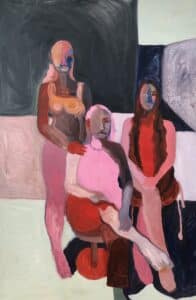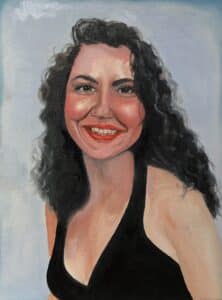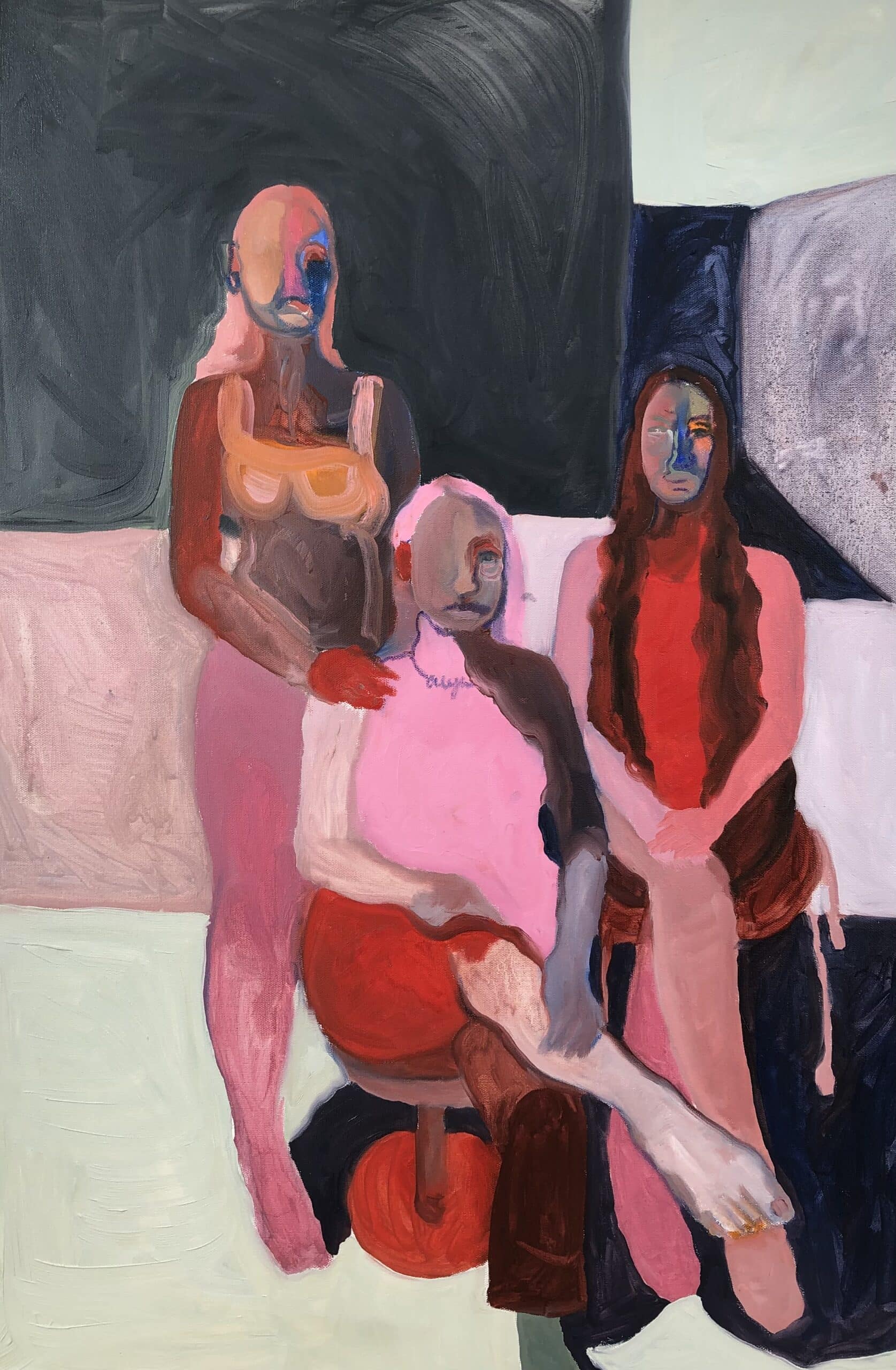Focusing on embracing, an interview with Raquel for The Ramp Gallery
Q&A written by Rebeca Abidail Flores, Gallery Coordinator
Focusing on embracing, an interview with Raquel for The Ramp Gallery
Before we began our conversation, Raquel and I danced to GATÚBELA by Karol G. Her show in The Ramp Gallery is on view during our Día De Los Muertos celebration and in this new body of work, Raquel honors the life of her Tía. She zoomed in from Sacramento, California, the dance helped us set the tone for a conversation on honoring grief with painting, embracing constant transformation and releasing expectations for the unknown. While Karol G set the stage with her song about yearning, for a brief moment Raquel shares with us the beauty in learning how to yearn.
Raquel: Physically I’m here, mentally, I’m in a lot of places all the time–at once. I just had my show at Root Division, and that was really exciting. It took up a lot of my mental space. As far as where I am with art, it’s just been really kind of overwhelming but fun. I haven’t really ever done that before.
SOMArts: First of all, congratulations! When you say you haven’t done ‘that’ before, do you mean a double feature?
Raquel: Yeah! I’ve shown my work but I would just show things that I had already made. I think for these shows, it was the first time I said to myself, I’m gonna make something specifically for these. It’s been overwhelming and I put a lot of pressure on myself to show the thing that I’ve been wanting to show.
It’s me trying to say so much in such a small space in such a short period of time. I probably put too much pressure on myself. This was my first time starting from scratch for a show and I’m doing it back to back. So it’s been a lot trying to get to it all and completed by the right time.
SA: It is a lot of work but also a big step in your career as an artist. A huge accomplishment! Tell us about your painting process, what is it like to create work for a show?
Raquel: It’s very fluid.

I don’t really plan anything except the references that I use. That’s really just deciding which images I’m going to use when I’m working. Other than that, I just let whatever comes out, come out. I deal with so much anxiety in my daily life, that when I paint, I really just want it to be a space that’s non judgmental, feels free, and accepting of my mistakes.
When it comes to color, I literally look at my paints, and think, what color do I feel like using today? I choose a color and then I build off of that. If I’m looking at an image of somebody, there are colors that make me think of these people and they change over time,100% they change based on the image I’m looking at, or, that particular moment in time, and how I feel about them.
By painting, I’m teaching myself to accept my own mistakes because we’re all our own harshest critics. When I was in school, I became very aware of how when we are creating art, there’s huge pressure to create a thing that’s going to please an audience. I remember being really young, it was first grade and I will never forget this teacher, she used to make me sit aside by myself and draw. She would come over and be like, that’s not good enough and make me start over. She was literally putting me, you know, to the corner of the room, like separate from the rest of the students. I remember I got so obsessed with like, wanting to make something that she would say is good enough. When I would see all the colors laid out, I was like, Oh my God, there’s so many possibilities and I felt like I could create anything. I used to sit there for so long as a kid just making weird shapes over and over, because I wanted to create a shape that had never been created before. As artists, we’re very visually aware of what is trending and what is what people want to see and the ability to block that out, is a really big part of creating art. That’s really where my process is, it’s more of the mental work towards blocking out what I think people might want of me. It’s about getting in touch with myself and what I would want to come from me naturally.
When I started painting, I dealt with a lot of the internal conflict of: I know, this isn’t as aesthetically appealing or something that people might want to see, but I have so many things that I want to say with my art that I have to just do it anyway. I made it my goal to essentially just make that art. It’s not that I think my art is necessarily bad and if we want to get close, go with it. That can mean so many things, right? It’s just a way to free my mind. I want to say what feels most genuine to me.
SA: Really, at the end of it, if it makes you feel something that’s what counts. What do you feel in your show, Te Queiro Tía?
Raquel: I’m thinking about how my aunt passed away last year and this holiday is so beautiful, because it celebrates death instead of demonizing it and hiding it. When I think about my aunt, what really comes up for me is just how she taught us to live our lives. But through example, she was always the person to do fun things with everyone and keep the family together. She prioritized those ties so much. The best way to celebrate her is to focus on our younger generations.
the person to do fun things with everyone and keep the family together. She prioritized those ties so much. The best way to celebrate her is to focus on our younger generations.
The first portrait in the series is her, then the blue one with the two girls are my aunt’s daughters. These are my two cousins that I’m really close to. I want to focus on her legacy, of the way she approached life and living life especially in her last years. She influences us and how we live our lives and to me, that was the obvious thing to paint about. I was like, I have to paint us, how else will I show her?
As I’ve gotten older, I’ve realized more and more how American culture treats death and how unhealthy that is. I think that my relationship with grief now is more based on, actively looking to learn more about it and realizing that I would much rather celebrate life and get more comfortable with what that means to me.
SA: I’m noticing a trend of the faces in your paintings sort of being blurred out or have a little bit of distortion. What’s behind the decision to create portraits like this?
Raquel: It’s a running theme in my work. I keep it alive in my pieces, because it’s rooted in my attempt to move away from defining self identity as something static. Often we identify people through facial recognition and I like to distort and abstract faces, because it’s my way of saying that with every individual, there’s more than what the eye can see. There’s more to people than the categories and boxes we like, and might instinctively, or instinctually, put them in. I think that’s one of the most harmful things that we do to each other as social beings. I have always since school, since whenever, till now, and probably my whole life that I’m making art, this will be something that I’m constantly thinking about, learning from, and trying to add to the conversation of what that is.
SA: What do you think that conversation is?
Raquel: It’s different for everybody and that’s the trajectory that I’m taking right now. I think it’s very important to move away from that static definition of self identity that is very much propped up by media and pushes people to consume in order to define themselves. I think self identity itself is a myth. I think that it’s a word that has transformed over time and can be very limiting, because it makes us feel as though we are beings that can be defined at all. I think that focusing on embracing instability, embracing liminality, being okay with fraying at the edges and not knowing how you will react in a certain situation, all of that is just individual experience. Everybody’s gonna define it differently and that’s kind of the beauty of it.
Raquel’s exhibition is on view from September 29th, 2022 – November 4th, 2022
To learn more about this exhibition please visit here.
To learn more about their work please visit adrianaraquelart.com

